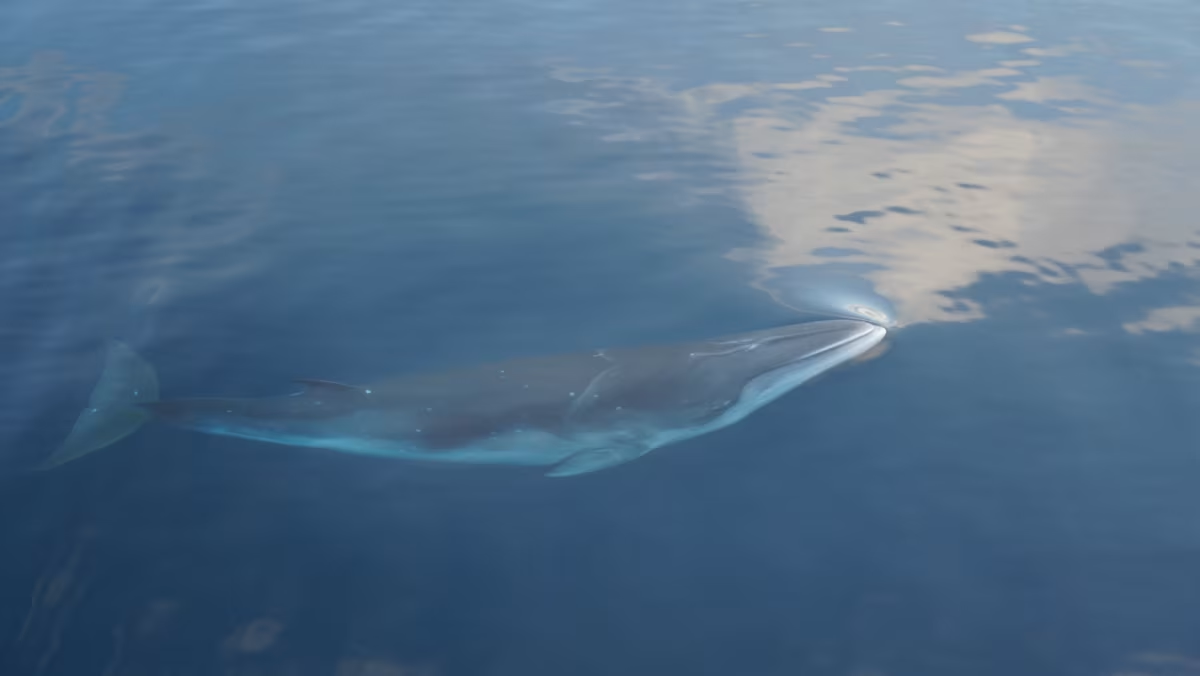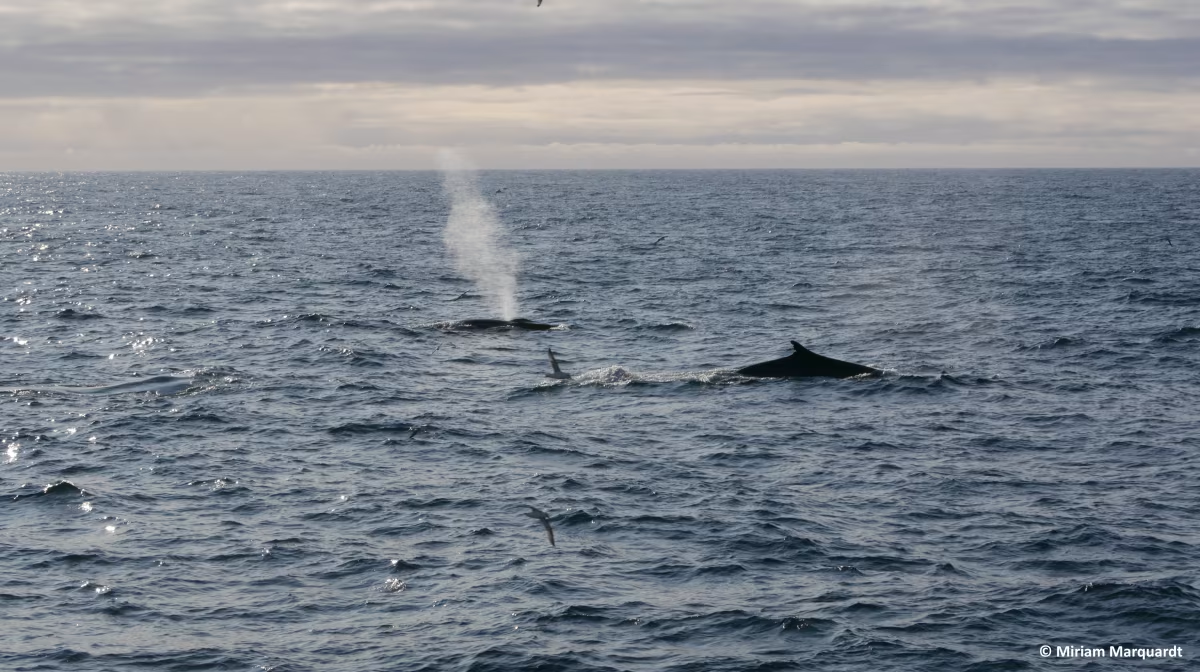At Oceanwide Expeditions, we have created numerous cruises and shore excursions around a long list of interests, including the Northern Lights and vikings. However, one of the most popular things that people ask to experience during their once in a lifetime, dream vacation is the opportunity to see and photograph whales.
The volcanic island of Jan Mayen is located in the Arctic Ocean, and it is considered to be part of Norway. This partially glacier covered island offers amazing views, and the water nearby is also a prime spot for whale watching.
What types of whales will I see?
There is never any guarantee that a specific marine mammal will make an appearance during a whale watching cruise. After all, the whales are not bound by any obligation to show up at a certain time, but we do have a good understanding of when and where to look for them in order to give you the best odds of seeing multiple species. On most trips, people will spot minke whales, fin whales and sometimes killer whales, and there is also a good chance that a blue whale or two will cross our path.
To help you get a better feel for the whales in the Jan Mayen area, we have compiled some information that will help you know which species you are seeing. This will also make it easier for you to get the most out of your whale watching experience because you will not need to divide your attention between looking at the whales and learning basic facts about them.
Minke whales
The minke whale is sometimes referred to as the little piked whale. These whales are smaller than most people expect, and this helps them hide in the water. Fortunately, they also make it a occasional habit to give into their curious nature by spending time swimming alongside moving vessels. Minke whales can keep pace with many boats due to the fact that they can swim as fast as 38.6 km (24 miles) per hour.
Aside from the minke whale’s relatively small body size, they can also be identified by their triangular, narrow upper jaw. These members of the baleen whale family have a slender and streamlined body, along with up to 300 whitish-yellow baleen plates. The stomach of a minke whale is white, but the top half of their body is black to dark grey. You might also notice a distinctive white band on each whale’s flipper. Most adult minke whales will range in size from 8 to 8.2 meters (26-27 feet), but it is possible for them to reach a length of 10.2 meters (33 feet).

Picture by Dolores Oiza
Fin whales
Unlike the minke whale, the fin whale is enormous and therefore nearly impossible to miss. The only larger mammal in existence today is the blue whale, so all of our cruise participants should have no problem spotting any fin whales that come near the boat. These whales can get as long as 24 meters (80 feet), and they weigh an astounding 80 tons (160,000 lbs).
This endangered species has a very distinct physical trait: they have black coloring on the lower portion of their left jaw, but the right lower jaw is white. There is also a very noticeable ridge behind each adult fin whale’s dorsal fin.
Fin whales have earned the nickname of “greyhounds of the sea” by being able to swim at speeds of up to 37 km (23 miles) per hour. Although this is actually slightly slower than the fastest minke whales, it is still very impressive because of the sheer size of each fin whale. In a single day, these marine mammals can eat as much as 2 tons (4,000 lbs) of krill and small fish.

Picture by Miriam Marquardt
Killer whales
Killer whales, which are also commonly referred to as orca whales, are known to have complex social structures and rich emotional lives. According to some scientists, they are on a similar level with humans, and there is even a big movement to have them granted non-human personhood status so that they can no longer be held in captivity. It remains to be seen if this movement will be successful worldwide, but it is obvious to our team that killer whales are intelligent, emotional beings that are by far best observed in their natural habitat. After all, the ocean is where they can truly be the best and most authentic version of themselves.
Killer whales can become as long as 9.7 meters (32 feet), and they weigh up to 6 tons (12,000 lbs). They are easily identified by their distinctive fin and black and white coloring. These marine mammals communicate and hunt via echolocation, and their hunting party is a pod that contains up to 40 family members. Killer whales are part of the dolphin family, and they dine on sea lions, seals, seabirds, squid, fish and other whales.

Picture by Sara Jenner
Blue whales
This is the least common whale species in the Jan Mayen area, but it is still definitely possible to see them during many of our cruise expeditions. Blue whales are part of the baleen family, and they are the largest creature of any type that is ever known to have existed on earth. In other words, the blue whales that you might spot when our boat gets near Jan Mayen are bigger than the Tyrannosaurus Rex or any other dinosaur. The largest blue whales are 32 meters long (105 feet), and they can weigh as much as 200 tons (400,000 lbs). To maintain their size, it is necessary for them to eat 4 tons (8,000 lbs) of krill every day. When they are in their first year of life, they will gain 91 kg (200 lbs) daily.
If you spot a blue whale while it is underwater, their giant body will appear to be a true blue color. When they surface, though, their coloring is revealed as bluish-grey. A non-agitated blue whale typically swims at a pace of 8 km (5 miles) per hour, but if they are bothered by something, they can quadruple this speed. One of the most exciting things for whale watchers is seeing a blue whale exhale through its blow hole. In some cases, the water will shoot as high as 12 meters (35 feet) up into the air!

Picture by Ingrid Peters
Go on a whale watching adventure
Cruising into local waters might give you the chance to see a few interesting marine mammals, but taking a true adventure with Oceanwide Expeditions will put you in the best possible position to see everything from whales to remote island locations such as Jan Mayen. Each of our expeditions is planned to ensure that every participant has a memorable, once in a lifetime experience that cannot be duplicated anywhere else. If you are ready to leave your normal life behind for a week or more, we have a diverse list of whale watching opportunities available that will make it easy to unwind and take in the natural beauty of the world.






